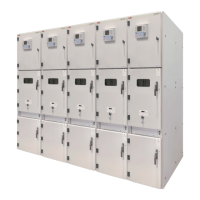13
The voltage transformers mounted fixed are connected on the primary side with flexible, fully- insulated
cables which are inserted in the transformers.
The removable voltage transformers are fitted with HRC fuses. The EK6 type earthing switch can be
used with either a manual or motor-operated mechanism.
Its switching position will be indicated both mechanically by indication on the shaft and electrically by
means of the auxiliary switch. Earthing switch in 550 series cannot be equipped with a motor-operated
mechanism.
Three surge arrestors can be mounted fixed, instead of one position of single-core cables.
Cable connection of 12/17.5 kV units
In the 550 and 650mm wide panel, up to three parallel plastic cables can be connected with single-
core cable protection and push-on sealing ends with a maximum cross-section of 630mm².
In the 800 or 1000mm wide panel, up to six parallel plastic cables can be connected with single-core
cable protection and push-on sealing ends with a maximum cross-section of 630mm².
Customer requests regarding connections to bars, three-core cables, special cables or sealing ends
of different types must be considered during the order-planning stage.
Cable connection of 24 kV units
In the 800mm wide panel, up to three parallel plastic cables can be connected with single-core cable
protection and push-on sealing ends with a maximum cross-section of 500 mm².
In the 1000mm wide panel, up to six parallel plastic cables can be connected with single-core cable
protection and push-on sealing ends with a maximum cross-section of 500 mm².
For more information regarding cable connection, see chapter 5.9.
For detailed information about cable connections, please make reference to the figures
102...106.
The cable connections are supplied without screws, washer and nuts; the supply of this
material, according to the cable termination, is at Customer charge.
3.3.5 Control cabinet (Figures 2, 4)
The control cabinet is, for all control and protection aspects, suitable for both conventional or
microprocessor control technology.
The height of the control cabinet is 705/1100mm. For details, see chapter 2.3.
If the secondary devices are not intended for door installation, they are mounted on DIN RAILS. They
enable any subsequent changes to the wiring. In the lower part of the control cabinet, there are three
rows of DIN RAILS on the swivelling DIN RAIL holder and, below these, there is an easily accessible
auxiliary switch for the control wiring plug.
Secondary wiring inside the panel is in a duct on the right side of the panel. The left side of the panel
is for the external wiring. The ducts are covered with steel sheet metal 43.1, 43.2. There are holes for
sliding in the ring conductors at the side of the control cabinet.
3.3.6 Switch-disconnector and cable compartment in the panel with switch-disconnector
The switch-disconnector and cable compartment is merged. The switch-disconnector is mounted
stationary and connected to busbars. The interconnection to the busbar compartment is carried out
by means of bushings, which secures the separation of busbar compartment from all other switchgear
compartments.
The switch-disconnector and cable compartment is also separated from other compartments by
means of metal partitions.
The switch-disconnector can optionally contain an integrated earthing switch. The switching positions
of the integrated earthing switch type E can be indicated by an auxiliary switch.
Closing and opening of the switch-disconnector is performed manually by means of a lever with the
door closed. On request the device can be also mounted for motor operation of switch-disconnector.
The switch-disconnector can consequently be operated not only locally but also remotely. The earthing
switch is always operated locally by means of the operating lever.
The switchgear is constructed for the use of one-core cables as standard. The cable compartment
usually contains supporting insulators for fastening cables. On request the cable compartment can
contain the instrument current transformers instead of supported insulators. If all three current
transformers are not required, the relevant insulators are installed instead of them.
Cable connection in the panels for 12 kV, 17.5 kV and 24 kV:
In the panel with switch-disconnector 1 plastic one-core cable can be connected on each phase with
the cross-section up to 240mm² as standard.
Important note
In the case of any atypical cable connections an agreement must already be reached between
customer and manufacturer in the technical preparation stage of order.

